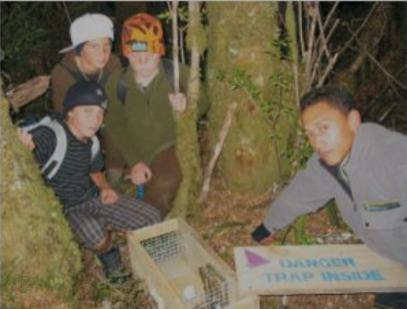wetlands are an important part of the Tongariro-taupo area. see: WEtlands are wonderful! article by Nick Singers in the (Click here) Tongariro journal 2005 - page 60.
waimarino was originalLY THE name of the current township 'National Park'. Waimarino Recreation reserve is a rich mix of dry land, wetland and open water lagoon, with native plants and birds important to wildlife conservation, all of which HAVE benefiTED from removing grey and crack willow choking the reserve in the past and replanting native trees.
South Taupo Wetland is an example of a wetland type unusual in New Zealand. It is notable because of its large extent (1500 Ha), the variety of wetland habitats occurring within a single wetland area, and its location (a large wetland on a lake edge).
The wetland supports populations of two globally threatened species of birds, New Zealand dabchick and Australasian bittern and an exceptionally high diversity of plant and bird species, and is thus of special value for maintaining the genetic and ecological diversity of the region. The wetland is an important breeding area for various waterfowl including three types of cormorant, black swan, three types of duck, and scaup.
The wetland is of special value for its endemic species and communities. Sixteen endemic species of birds have been recorded in the area. The wetland regularly supports approximately 4% of the New Zealand population of black swan. (Source: Cam Speedy and Cathy Jones)
There are about 131 more wetlands in the Tongariro Taupo Conservancy including swamps, marshes, ephemeral wetlands, bogs, fens and alpine flushes. to find out more turn to page 33 in the [click here] Tongariro Journal 2009.
HISTORY
1847 - Stump Bay on the south side of the wetlands was the site of an impressive Maori Pa under the paramount chief Mananui Te Heuheu.
1941 - Lake Taupo control bridge was completed in September 1941, which created significant increase in the lake level, resulting in more regular flooding of the wetlands.
2001 - Vegetation monitoring with volunteer involvement in the South Taupo Wetlands lead to development of suitable methods of controlling Grey Willow, which is an introduced invasive weed that is spreading into wetlands at high rate.
2004 - Forest managers remove all willows in several hundred hectares of wetlands in the Mangaharakekenui Wetlands. Botanist Nick Singers draws attention to the threat of willow invasion in the Lake Rotoaira basin wetlands. Research on the presence of willows and control work is also extended to the Tokaanu Wetlands.
2007 - The battle along the Waimarino River [See Tongariro Journal 2008 page 59] against broom, buddleia, old man's beard, celastrus and willows is ongoing and progress is good. With help from Project Tongariro the number of Waimarino wetland willows is reducing. The society is also helping to propagate mistletoe and Dactylanthus.
Ohakune Pimary School students placing stoat traps - photo: Aniwa Tawa
2009 - Eight primary schools held a wetlands workshop with a visit to the Rotokura Ecological Reserve dry lake (NW of Lake Rotoaira), which is a good example of a wetland in excellent shape. Students learned that wetlands are home to very special plants, birds, fish life and invertebrates. We can only hope that they carry that through to adulthood as the Kaitiaki (caretakers) of the future.
From Willows to Native Trees - Te Matapuna Wetlands
2014 - Work at Te Matapuna Wetlands has expanded with three Hapu committing to a partnership with Doc. This greatly increases the land to be restored and commits to important cultural values in addition to the ecological ones. Removal of Grey willows is physically difficult and most successful through drilling and poisoning mature trees. The local Tongariro Prison will develop a nursery which will grow 10,000 locally eco-sourced trees per annum to replace the willows with native trees. For more details: click here - Tongariro Journal 2013/2014 - page 25.
Volunteers planting native trees at Te Matapuna wetlands - photo DOC
2015 - Work at Te Matapuna wetlands was started in 2005 and is not coordinated with DOC and the hapu of Ngati Hine, Nati Rongomai and Ngati Te Rangiita. A significant boost has been received in the form of a 'Community Conservation Partnership Fund (CCPF)' grant of $208,000. This will pay for up to 10,000 naive plants per year and removal of willows. Plants are grown at a nursery provided by the department of corrections and planted by mainly volunteers.
If you want to join this group become a volunteer!
2016 - Work on Te Matapuna - Waiotaka Wetland Restoration is continuing: see Tongariro Journal 2016 page 80: CLICK HERE
Similar work is being done alongside the Waimarino and Tauranga-Taupo rivers, Oruatua Ave, etc. A trap network is also set up at Waitetoko to bring back the birds. Local volunteers are maintaining the trap lines, in the future we hope to have involvement from students at MiCamp Christian Camp.
Volunteers have set up Predator Free Motuoapa in an effort to bring back the birds.









